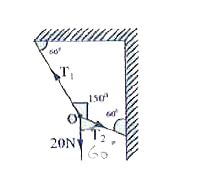(A): When a particle moves in a circle with a uniform speed, its velocity and accele ration both changes.
(R): The centripetal acceleration in circular motion is dependent on angular velocity of the body.Solution in Telugu
Both (A) and (R) are true and (R) is the correct explanation of (A)
Both (A) and (R) are true and (R) is not the correct explanation of (A)
(A) is true but (R) is false
Both (A) and (R) are fals
The correct Answer is:B
Step by step video, text & image solution for (A): When a particle moves in a circle with a uniform speed, its velocity and accele ration both changes. (R): The centripetal acceleration in circular motion is dependent on angular velocity of the body. by Physics experts to help you in doubts & scoring excellent marks in Class 12 exams.
Topper's Solved these Questions
- BOOK - AAKASH SERIESCHAPTER - MOTION IN A PLANEEXERCISE - EXERCISE-2 (Addition, Subtraction and Resolution)29videos
MOTION IN A PLANE
- BOOK - AAKASH SERIESCHAPTER - MOTION IN A PLANEEXERCISE - EXERCISE-2 (Lami.s theorem :)8videos
MOTION IN A PLANE
- BOOK - AAKASH SERIESCHAPTER - MOTION IN A PLANEEXERCISE - EXERCISE-IB (Projectile motion)15videos
MOTION IN A PLANE
- BOOK - AAKASH SERIESCHAPTER - MAGNETISMEXERCISE - PROBLEMS (LEVEL-II)13videos
MAGNETISM
- BOOK - AAKASH SERIESCHAPTER - MOTION IN A PLANEEXERCISE - QUESTION FOR DESCRIPTIVE ANSWER7videos
MOTION IN A PLANE
Similar Questions
A person runs along a circular path of radius 5 m. If he completes half of the circle find the magnitude of the displacement vector, How far the person ran ?
02:43View SolutionIf 'O' is at equilibrium then the values of the tension T1andT2 are x, y, if 20 N is vertically down. Then x, y are
 02:43View Solution
02:43View Solution(A): The horizontal displacement of a projectile varies linearly with time.
(R) : Projectile motion is uniform motion along horizontal direction.02:51View SolutionThe force between the two poles is reduced to 'x' newtons when their separation is increased n times. It is increased by 'y' newtons when their separation is made 1/nth of their original value. What is the relation between x and y?
02:03View SolutionA particle is projected over a triangle from one end of a horizontal base and garzing the vertex falls on the other end of the base . If α and β the base angles and θ the angle of projection then show that tanθ=tanα+tanβ.
View SolutionA particle is moving along a circular path with uniform speed. Through what angle does its angular velocity change when it completes half of the circular path ?
03:13View SolutionA particle is moving along a circular path with uniform speed. Through what angle does its angular velocity change when it completes half of the circular path?
02:55View SolutionSTATEMENT-1: When a particle moves in a circle with a uniform speed, it velocity and acceleration both changes. STATEMENT-2: The centripetal acceleration in circular motion is depdendent on angular velocity of the body.
02:59View SolutionA body moving along a circular path of radius R with velocity V , has centripetal acceleration a If its velocity is made equal to 2v , then its centripetal acceleration is
03:04View SolutionAssertion : When a particle moves in a circle with a uniform speed its acceleration is constant but the velocity changes. Reason : Angular displacement is not a axial vector.
01:49View Solutionएक कण एकसमान वृत्तीय गति कर रहा है | अर्धचक्र में उसके कोणीय वेग में कितना परिवर्तन होगा ?
01:51View SolutionA particle is describing uniform circular motion on a circle of radius 5cm with speed of 10cm/s ,its centripetal acceleration will be?
03:31View SolutionStatement I. When the particle moves along the circular path at a uniform speed, both its velocity and acceleration change. Statement II The concentric force in circular motion depends on the angular velocity of the object.
View Solution(A): Acceleration of a moving particle can change its direction without any change in direction of velocity.
(R) : If the direction of change in velocity vector changes, the direction of accele ration vector also changes.01:51View SolutionA particles is moving on circular path of radius R with constant angular velocity omega . Its centripetal acceleration will be …... .
01:08View Solution

